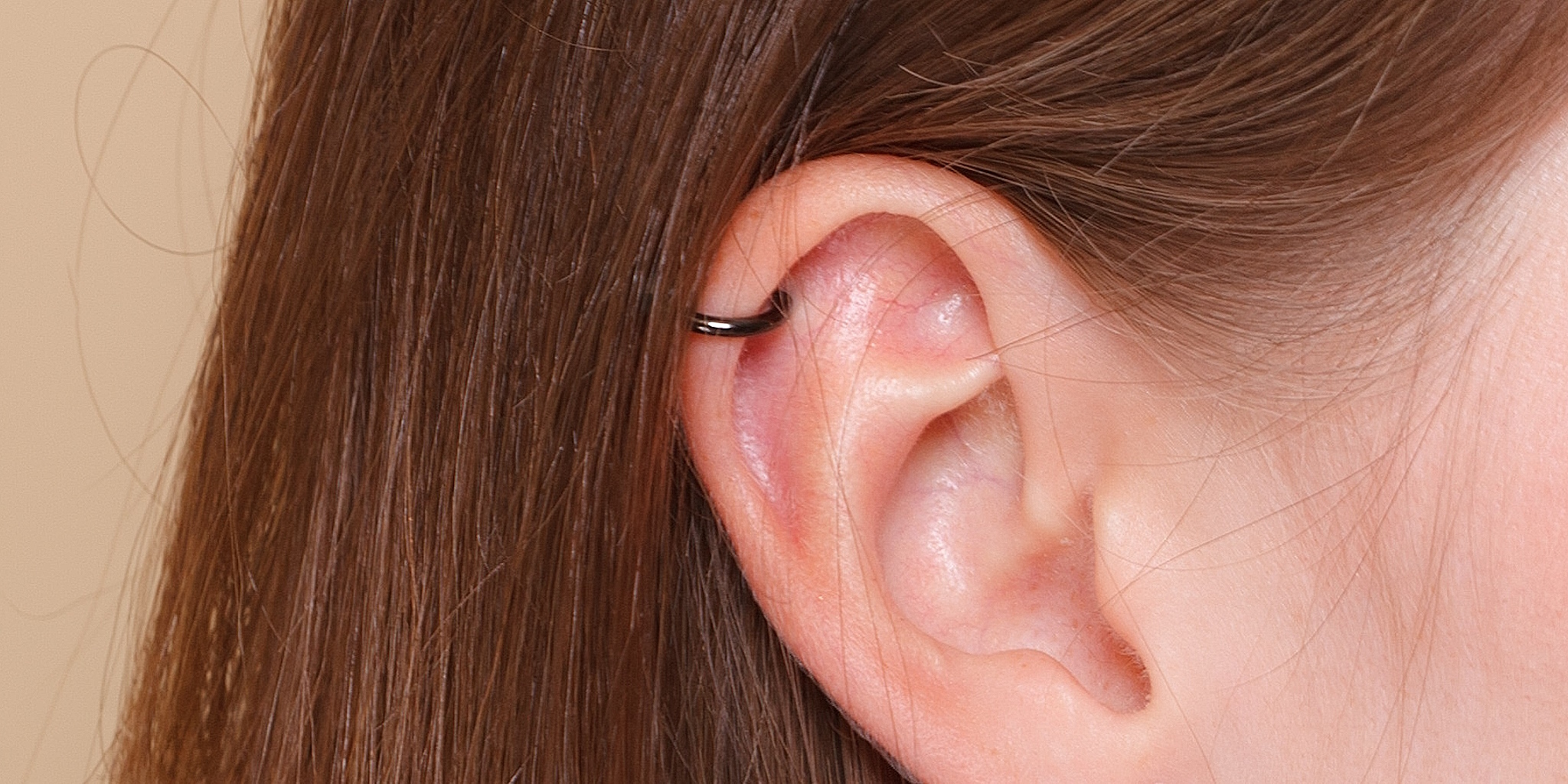
Helix Piercing Details: Gettin’ Down To The Nitty Gritty
Helix Piercing Article Quick Reference:
History | Myths | Complications | Pain | Cost | Procedure | Healing | Aftercare | Jewelry | Celebrities
The helix piercing is located on the upper ear cartilage, where the ear begins to curve upward toward the top of the head. More specifically, it sits on the outer rim of the upper ear, just above the tragus (the small, triangular-shaped cartilage on the front of the ear).
The exact placement of the helix piercing can vary depending on personal preference, but it is typically located about 1-2 centimeters above the earlobe. It is a popular piercing choice due to its versatility and ability to be styled with various types of jewelry. To see the specific location, check out the diagram below.
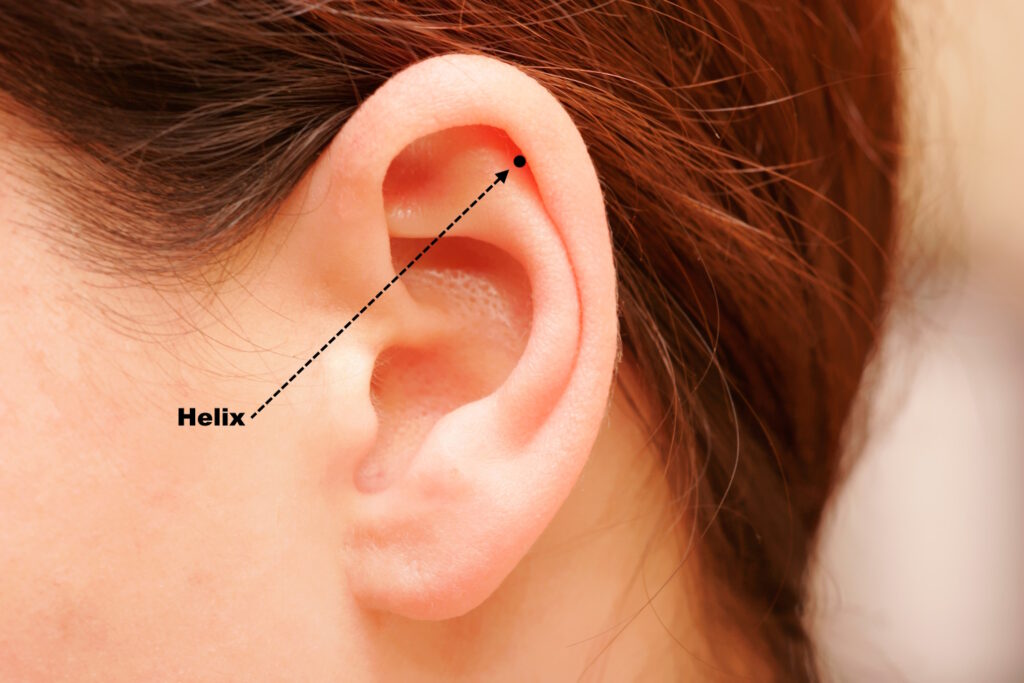
HELIX PIERCING HISTORY
The history and cultural significance of the helix piercing varies across different cultures and time periods.
Firstly, in ancient Rome, ear piercing including helix piercing was a sign of nobility and wealth. The piercing was also a form of adornment, and it was common for Roman women to wear intricate earrings.
Secondly, in native American cultures, ear piercing including the helix piercing was a rite of passage for young girls, a symbol of their coming of age.
Thirdly, in African tribes, ear piercing was a sign of social status, with the size and weight of the earring highlighting the wearer’s wealth.
Finally, in modern times, the helix piercing has come to signify individuality and rebellion in punk and rock subcultures, while also being a fashion statement for people across many different lifestyles and cultures.

MYTHS & MISCONCEPTIONS
There are several common myths and misconceptions about helix piercings. Here are a few:
- Helix Piercings Are The Same As Cartilage Piercings: Wrong! Sure, the helix piercing goes through the rim of your ear which is cartilage. But that doesn’t mean it’s the same as any old cartilage piercing!
- Helix Piercings Take A Very Long Time To Heal: Honestly, it’s all relative. If you blink and it’s been six months since your piercing, then maybe it’s not true! But if you’re counting down every single day, it can feel like an eternity.
- Helix Piercings Are Very Painful: While everyone’s pain tolerance is different, helix ear piercings are generally not very painful. The initial piercing may cause a quick, sharp pain, but many people report that the pain is not as bad as they expected.
- You Can Only Wear Certain Types Of Earrings In A Helix Piercing: This is not true. Once your helix piercing has fully healed, you can wear any type of earring you like, as long as it fits comfortably in your piercing.
- Helix Piercings Are Dangerous And Can Cause Serious Health Problems: This is not true if you get your piercing done by a reputable piercer and take good care of your piercing during the healing process. Like with any piercing, infection or other complications always present a risk, but proper aftercare instructions can minimize these risks.
So fear not, if you’re intrigued by helix piercings, don’t let these myths or misconceptions scare you off. With the right planning and care, your stylish new addition will not be a real pain in the…well, you know where!
WHO IS THE HELIX POPULAR WITH?
Both men and women like helix piercings, and it’s not about gender. Helix piercings have become increasingly popular in recent years, and people of all genders are opting for this type of piercing. It’s all about personal taste and style. Some people may prefer a simple stud, while others may go for a bold statement earring. Ultimately, it’s up to the individual to decide if a helix piercing is right for them, regardless of their gender.
They have also become increasingly popular among people of all ages in recent years. However, it’s difficult to pinpoint a specific age group that wears them the most. People of all ages, from teenagers to adults, are opting for this type of piercing. Younger people may prefer more trendy and bold styles, while older individuals may opt for a more subtle and classic look. Ultimately, anyone can wear a helix piercing, and it’s about personal expression rather than age.
The legal age to get a helix piercing varies depending on the country or state. In many places, the legal age for ear piercings is 18 years old without parental consent. However, some places allow minors to get ear piercings with parental consent. It’s always important to research the laws and regulations in your specific area before getting a piercing. Regardless of the legal age, it’s essential to choose a reputable piercer and discuss any concerns or questions with them before getting a helix.
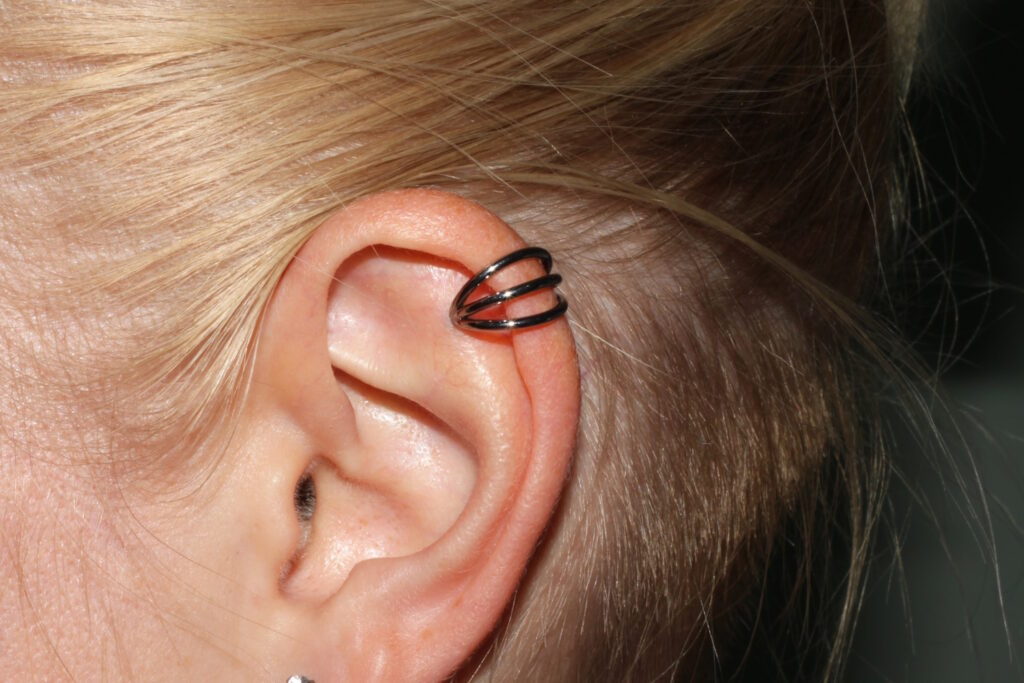
THE POSSIBLE RISKS
Now don’t panic, folks – it’s not all doom and gloom. But like any piercing, it’s essential to be aware of the potential risks and complications before diving headfirst into the world of the helix. So, let’s take a look at what could go wrong:
While helix piercings are relatively low-risk, there are some potential risks and complications that you should watch for during and after the healing process. Here’s a brief rundown:
- Infection: Any piercing carries a risk of infection, and the Helix piercing is no exception. Signs of infection include redness, swelling, heat, and discharge from the pierced area. If you notice any of these symptoms, it’s essential to see a healthcare professional.
- Keloids And Scarring: Some people may develop an overgrowth of scar tissue after a helix piercing, which can create raised bumps or keloids. Proper aftercare and keeping the piercing clean can help prevent excessive scarring.
- Allergic Reaction: Some people may have an allergic reaction to the metal used in their helix piercing. Nickel allergy is common, and if you have sensitive skin or a known allergy, you should choose appropriate jewelry.
- Damage To The Surrounding Area: If the piercer performs the piercing incorrectly or if the earring is too tight, it can cause damage to the surrounding skin. It’s important to choose a reputable piercer and follow aftercare instructions carefully.
If you experience any pain, swelling, or other unusual symptoms after getting a helix piercing, it’s important to seek medical attention right away. While these complications are rare, it’s always better to err on the side of caution regarding your health.
THE COMPLICATIONS
There are also a few health conditions that you should consider before getting a helix ear piercing. Here are a few examples:
- Bleeding Disorders: If you have a bleeding disorder or are taking blood-thinning medication, you may be at a higher risk of bleeding excessively during the piercing process.
- Skin Conditions: If you have a skin condition such as eczema or psoriasis, it may be more difficult for the piercing to heal correctly. The piercer may also need to take additional precautions or avoid certain products during the healing process.
- Chronic Illnesses: If you have a chronic illness such as diabetes or an autoimmune disorder, it may take longer for your piercing to heal or increase the risk of infection. It’s important to discuss any underlying health conditions with your piercer before getting a helix piercing.
Overall, it’s important to consider any health conditions before getting a helix piercing and to discuss any concerns with your piercer. In some cases, it may be necessary to get a doctor’s approval before proceeding with the piercing.
CAN A HELIX PIERCING BE REVERSED?
Yes, a helix piercing can be reversed if desired. If you want to remove the piercing, you can simply take out the jewelry. However, the healing time can vary depending on how long you had the piercing and how well it has healed.
After having a helix piercing for several years, you may notice a small hole left behind once the jewelry is removed. This hole can take some time to close up completely, but in most cases, it will eventually heal on its own. Healing can take anywhere from a few days to a few weeks, depending on the person, the length of time the piercing was in place, and other factors such as how well the piercing was cared for and the age of the person.
HELIX PIERCING PAIN AND PAIN MANAGEMENT
Ah, the age-old question of helix piercings: How much does it hurt? Well, buckle up, folks, because it’s time to talk about the dreaded P-word…pain! Don’t worry; it’s not as bad as it seems.
The pain level of a helix piercing varies from person to person. Generally, it’s reported as less painful than a root canal or a tax audit. The piercing itself can feel like a quick, sharp pinch that’s over before you know it. So if you’re the type of person who hates needles, just try to focus on something else – like the cute new earrings, you’re going to be able to wear when it’s all over!
To manage any discomfort during or after the piercing, there are a few things you can do. Take some ibuprofen or acetaminophen, remind yourself that you’re a boss, and breathe! You could also try thinking happy thoughts, envisioning yourself on a fancy yacht, or pretending you’re taking part in a daredevil stunt. Whatever works for you!
Overall, any pain associated with a helix piercing should be temporary and manageable. And if you’re still feeling down, just remember that “pain is temporary, but earrings are forever” (or at least until you take them out).
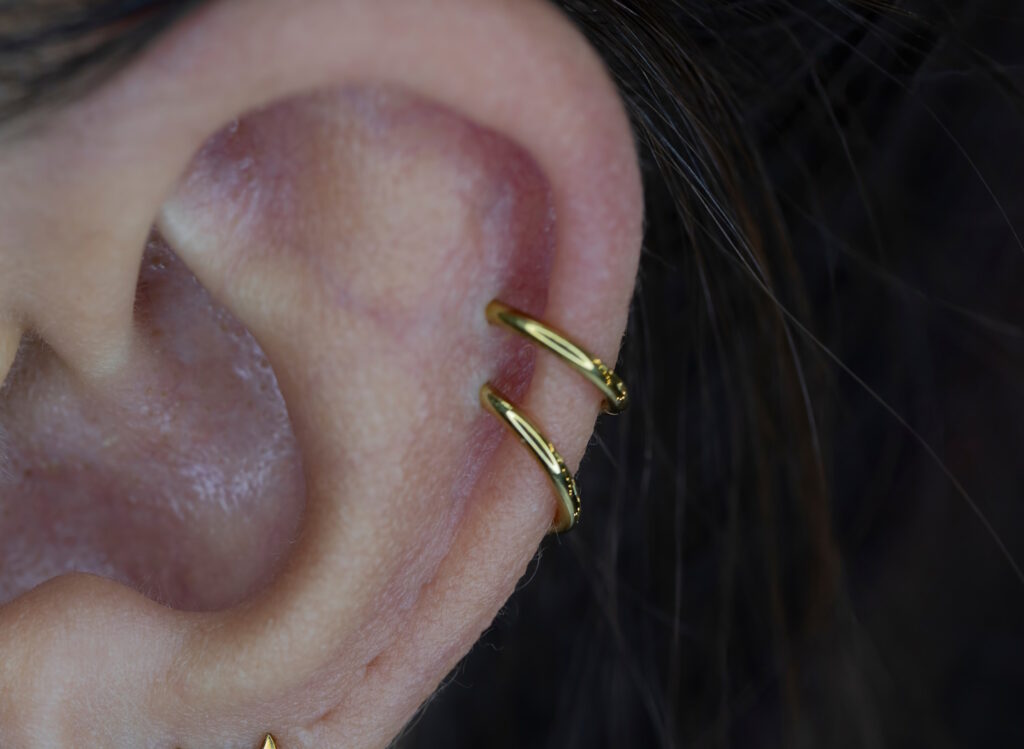
CAN YOU AFFORD A HELIX EAR PIERCING?
So, you’re thinking of getting an awesome helix piercing? Well, buckle up, buttercup, because it’s time to talk about the cash. Here are the average piercing costs in each of these regions:
- South: The average cost of a helix piercing in the South is usually between $30 to $60.
- East Coast: The cost of a helix piercing on the East Coast is typically more expensive than in the South, with an average price range of $40 to $70.
- West Coast: The average cost of a helix on the West Coast is often higher than in other areas of the country, and you can expect to pay between $50 to $100 or more, depending on the location and studio.
- Midwest: In the Midwest, the price can range from $30 to $60, with some larger cities like Chicago or Minneapolis potentially charging slightly more.
Well, that’s it folks – the scoop on the cost of a helix piercing around the USA. Regardless of where you live, just remember the age-old adage “You get what you pay for.” So, if you’re serious about piercing that outer ear cartilage, make sure you’re not skimping on price over quality. Otherwise, you might end up with a piercing that looks more like a third eye than the chic, trendy addition you were going for.
HELIX PIERCING PROCEDURE: THE FUN IS JUST BEGINNING
Helix piercings are typically done using a gauge size of 16 or 18. A gauge 16 needle has a diameter of 1.2 millimeters, while a gauge 18 needle has a diameter of 1 millimeter.
Let the piercing procedure begin:
- Consultation: The piercer will ask some questions about the client’s medical history, specifically with regards to skin conditions and healing ability.
- Sanitizing The Hands: This is the step a piercer takes to ensure a sterile environment for the piercing. They will use an alcohol-based hand sanitizer and put on single-use gloves to prevent cross-contamination.
- Preparation: The piercer will then clean the helix with an antiseptic solution to disinfect it and prepare it for piercing.
- Marking The Position: The piercer will use a sterile surgical marker to mark the entry and exit points of the intended piercing. Before proceeding, the piercer will ask the client to confirm that they are happy with the placement of the marked points.
- Piercing: The piercer will use a sterile needle to create the piercing. They will insert the needle through the marked entry point until it’s visible at the exit point, and then pull it through. The needle is then set aside.
- Inserting Jewelry: After the piercing is completed, the piercer will quickly insert the jewelry which was chosen beforehand, usually a small diameter stud. They ensure that it’s securely in place and fastened.
- Aftercare Instructions: Lastly, the piercer will provide aftercare instructions to the client. These instructions include how to clean the piercing site, how to avoid infections, and instructions about what to avoid in the days after the procedure.
It is essential to choose a reputable piercer who follows proper hygiene protocols and takes proper care of the piercing afterward to avoid complications and facilitate quick, safe healing.
TALES OF HEALING
A helix piercing can be a fantastic accessory, as long as you’ve got the patience to wait for it to heal. You see, unlike an earlobe piercing, which takes about six weeks to heal, a helix piercing is different. Helix piercings can take up to 6 to 9 months to heal completely. But don’t worry, it’s not all bad news.
During the healing time of your helix ear piercing, you get to show off your new piercing while also showing off your patience and determination. You’ll learn how to handle the awkward dance of trying not to mess up your new accessory while trying to keep it clean and safe. And once it’s all healed, you’ll have a stylish accessory that will make all your friends want to get one too. So invest in a good piercing care routine, avoid any painful incidents, and just wait it out.
HELIX PIERCING AFTERCARE TIPS
Let’s dive deep into these helix piercing aftercare tips:
- Keep Your Piercing Clean: Use saline solution to wash your piercing with twice a day. You may also use mild, unscented soap to clean your piercing. Once you’ve washed the piercing, rinse it thoroughly with plain water. After cleaning your piercing, gently pat it dry with a clean and dry microfiber cloth or paper towel. Don’t use a regular towel or cloth, as they can harbor bacteria.
- Do Not Touch Your Helix: Touching or picking at your piercing can introduce bacteria into the wound and prolong the healing process.
- Do Not Sleep On The Piercing: Try to avoid sleeping on the side with the piercing to prevent irritation or pulling: If you can’t sleep any other way, try using a travel pillow or investing in a specialized pillow designed for piercings.
- Wear Loose Clothing: Wear loose clothing that doesn’t get caught on your piercing: Don’t wear tight turtlenecks, pullover shirts or clothing that can catch on your piercing, like scarves. Also, avoid wearing hats and headphones.
- Do Not Submerge Your Piercing: Bacteria pack public pools and hot tubs and can easily infect your piercing. Wait until your piercing has completely healed before taking a dip.
- Avoid Irritants: Do not use any beauty products like moisturizers or hair products on or around your piercing.
- Eat A Healthy Diet And Stay Hydrated: A balanced diet can help your body heal faster, so eat plenty of fresh fruits and vegetables and stay hydrated by drinking plenty of water.
By following these tips, you can help ensure that your helix piercing heals properly and quickly. If you experience excessive swelling, pus, redness, or pain, seek medical attention as quickly as possible.
JEWELRY CHANGE: THE TIME HAS COME
After getting a new helix piercing, experts generally recommend waiting at least 6 to 9 months before changing the jewelry. This is because the piercing needs time to heal and any trauma caused by changing the jewelry too soon can delay the healing process or even lead to complications such as infection or irritation.
When you are ready to change the jewelry in your helix piercing, here are some tips to follow:
- Gentleness Is Key: Don’t get too excited and make sudden movements or tugs. Your ear isn’t a toy claw machine, after all. Be gentle when removing and inserting the new bling!
- Fit Is Important: “If the shoe doesn’t fit, don’t force it on your helix,” or however the saying goes. Stay clear of tight or uncomfortable pieces. Ain’t nobody got time for that!
- Bathing The Ear & Jewelry: Give it a nice little bath before popping in your new bling. The same goes for your ear! Use some saline solution or unscented soap. We don’t want any party crashers (bacteria) ruining our fun. Rewash your helix after the change also.
- Don’t Miss The Signs: Keep an eye out for any suspicious activity. Redness, swelling, or discharge? Not cute, sweetie. If you see anything fishy, seek professional advice. Better safe than sorry!
Remember, changing jewelry in a helix piercing can be tricky and should only be done when the piercing is fully healed. If you are unsure or uncomfortable about changing the jewelry yourself, seek the assistance of a professional piercer.
WHAT TO WEAR, WHAT NOT TO WEAR
The following materials are all great choices for helix piercings and offer different benefits depending on your preferences and needs.
- Surgical Stainless Steel: This is one of the most popular materials for piercings due to its durability, affordability, and hypoallergenic properties. It resists corrosion, rust, and tarnishing, making it an ideal choice for long-term wear. It’s important to choose surgical-grade stainless steel, which is specially formulated for use in medical applications.
- Titanium: This is another popular metal used in piercings. It’s lightweight, hypoallergenic, and resistant to corrosion, making it perfect for those with sensitive skin. It comes in a variety of colors and finishes, including polished, matte, and anodized.
- 14K Or Higher Karat Gold: Gold is an excellent choice for those who want a touch of elegance. It’s hypoallergenic, tarnish-resistant, and very durable. 14K or higher karat gold is recommended for piercings. It contains less alloy metals that can cause irritation or allergic reactions than lower karat gold.
- Platinum: Platinum is a high-end metal that is very durable, resistant to tarnishing, and hypoallergenic. It’s an ideal choice for those who want the best of the best in terms of quality and luxury. Platinum is also a great choice for those with sensitive skin, as it doesn’t contain any nickel, which is a common allergen.
Avoid jewelry made from inferior-quality metals, as they may cause irritation or allergic reactions in the piercing site. It’s also best to avoid using non-metallic materials like plastic, silicone, or acrylic. These materials may harbor bacteria.
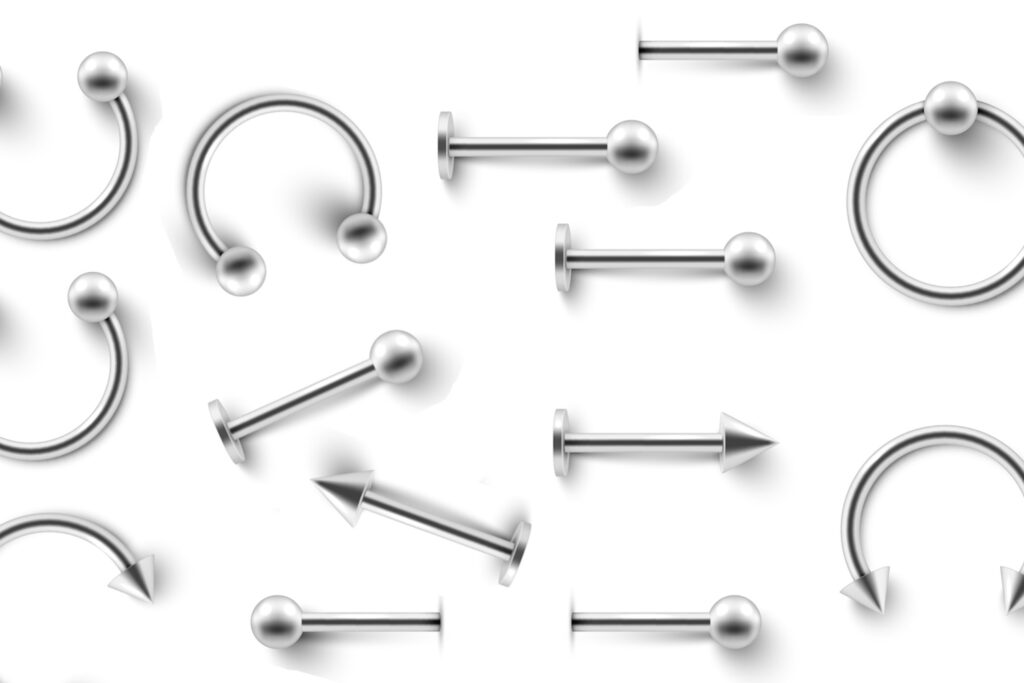
JEWELRY STYLES THAT FIT
When it comes to the style of jewelry that you should wear in a helix piercing, there are many choices. Here are some options that you have to choose from:
- Studs: The most common style of helix piercing jewelry. It consists of a single post with a flat back and a decorative front. Studs come in a wide variety of colors, materials, and designs, including gemstones, beads, and charms.
- Captive Bead Rings: Cute circular rings that demand attention! They’ve got a ball or a bead that is held in place by the tension in the ring. You can find them in all kinds of sizes and materials, perfect for turning heads.
- Segment Rings: These solid circular rings look like they have been teleported straight from the future! They’re designed to look like a full circle when closed and come in various widths and gauges.
- Barbells: Barbells consist of a straight metal bar with decorative ends. These are popular among those with multiple piercings as they can be paired with other styles of jewelry to create unique combinations. Barbells come in a wide variety of sizes, materials, and designs, including gemstones, spikes, and balls.
- Ear Cuffs: A style of jewelry that wraps around the outer ear. Some ear cuffs are designed to fit around the helix piercing specifically. Also, there are others suitable for different parts of the ear. Ear cuffs can be made from various materials, including metals, plastics, and silicone, and come in various designs and sizes.
These styles of jewelry can be further customized with various stones, colors, and metals. As always, consult with a professional piercer for recommendations and advice on which styles of jewelry are suitable for you.
CELEBRITY HELIX PIERCINGS
If you have always wondered what celebrities have a helix piercing, here you go, here’s a short list:
- Justin Bieber: Singer Justin Bieber has multiple piercings, including a helix piercing on his left ear. He often switches up his earrings, going for both hoops and studs.
- Keira Knightley: Actress Keira Knightley is known for her timeless beauty, and her helix piercing adds a modern touch to her aesthetic. She often pairs it with small, delicate earrings to keep the focus on the main piercing.
- Zayn Malik: Singer Zayn Malik has several piercings in his ears, including a helix ear piercing on his right ear. He often wears a hoop earring in this piercing, giving his look a trendy and edgy feel.
- Beyoncé: Queen Bey is known for her bold, statement-making style, and her helix piercing adds to this. She often wears hoop earrings in her helix piercing, making a statement with both her hairstyle and jewelry.
- Maisie Williams: Actress Maisie Williams has a subtle, single helix piercing on her left ear. She often wears small, delicate earrings in this piercing, making it a part of her everyday look.
- Lana Del Rey: Singer Lana Del Rey has multiple piercings in her ears, including a helix piercing on her right ear. She often wears hoops or statement earrings in this piercing, adding to her retro-inspired style.
If you want to be as stylish and fashionable as celebrities, getting a helix piercing may be the secret ingredient you need. However, let’s not forget that not everyone can confidently pull off a piercing. Therefore, it’s crucial to determine if a helix piercing is a suitable choice for you before fully committing to it.
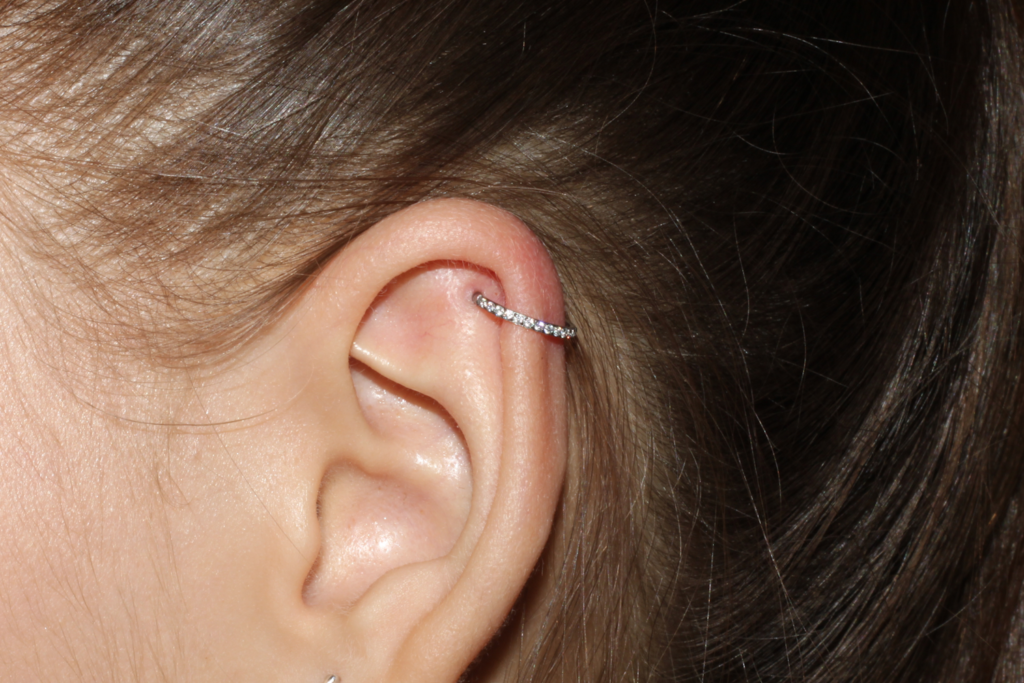
YOUR HELIX PIERCING VERDICT
Well, it looks like the helix ear piercing is the hottest accessory of the year. It’s even hotter than fanny packs and cargo pants combined! If you’re looking to add a subtle edge to your look, the helix piercing covers you. Now that you have information about the helix piercing it’s your decision. If you’re okay with the cost and procedure, it’s the first step in making your final decision. Just remember to care for it properly, or risk looking like a pirate whose ship never made it to shore. And if we’re being honest here, no one wants that. So, proceed with caution and make sure the helix piercing is really your cup of tea before taking the plunge. So what’s your verdict?
Need to find a piercer? Check out the Association of Professional Piercers.
Author: Scott S.
